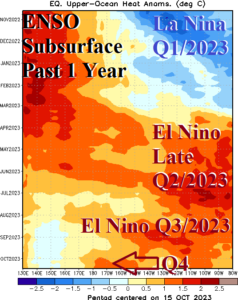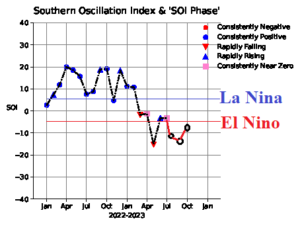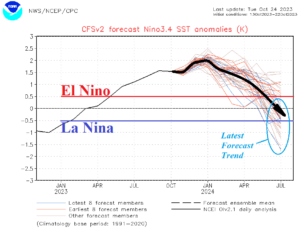Heavy Rains across Europe the Next 2 Weeks
10/22/2023, 2:46 pm EDTUnusually Expansive Wet Mid-Troposphere (For El Nino) Across Tropical Pacific
10/30/2023, 3:26 pm EDT
Fig. 1: Tracking the upper ocean heat across the equatorial Pacific Ocean during the past 1 year.
Discussion: Upper ocean heat supporting an ENSO phase change from La Nina to El Nino emerged during Q2 of 2023 in the eastern equatorial Pacific (Fig. 1). The subsurface warming in the East Pacific equatorial region peaked during July. Since that time, much of the subsurface warmth has shifted to the surface as oceanic El Nino has blossomed. The subsurface trend of late is a warmer westward push toward the Dateline. The Nino SSTA regions have shifted into a steady moderate-to-strong warm signature indicating a robust oceanic El Nino continues (Fig. 2). Atmospheric El Nino is not as strong. Steady negative southern oscillation index (-SOI) is an indicator of a stronger El Nino climate. The SOI trend is choppy negative in recent months and weaker negative phase for October (Fig. 3). The NCEP CFS V2 Nino34 SSTA forecast maintains peak strength of El Nino in January 2024 followed by rapid weakening of El Nino possibly into La Nina by the second half of 2024 (Fig. 4).
In summary, moderate to strong oceanic El Nino continues with peak strength of El Nino 2023-24 projected for January. The atmospheric El Nino is not as strong likely due to warm SSTA regions in the western equatorial Pacific and in the subtropics/middle latitudes of both the North and South Pacific indicating lack of typical thermal gradient normally present during El Nino when anomalous warmth convenes only in the tropical East Pacific. While forecast models forecast El Nino to weaken rapidly in 2024, the less energetic ENSO climate due to widespread warm SSTA patterns could delay El Nino’s demise in 2024.

Fig. 2: The 12-week monitor of the Nino SSTA regions indicates a steady moderate to strong oceanic El Nino.

Fig. 3: Monthly southern oscillation index for 2022-23.

Fig. 4: The NCEP CFS V2 Nino34 SSTA forecast indicates peak El Nino in January followed by rapid weakening.
